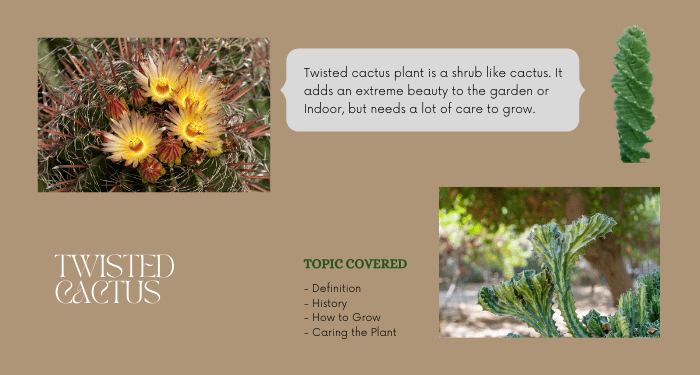Twisted cactus plant , as you can guess from the name itself, it is a cactus kind of plant. But this is not the only information, you need to know about this plant.
There is a lot of information related to this such as growing conditions, care or other issues. But a lot of people do not know about these and they would like to explore more about this plant.
So, here in this article, we would like to cover everything about this plant to satisfy your curiosity. Therefore, if you are one of those persons who would like to explore this plant, please go through the whole article till the end.
We hope we have presented enough information to help you in this matter.
What is a Twisted Cactus Plant?
The plant is a shrubby or tree like species generally. The Twisted cactus plant is a medium growing columnar cactus. This cactus grows up to 10 to 15 feet in height and 4 to 6 feet in width.
It is a trunkless cactus that forms numerous stems. They are usually darker blue-green in color and have longer spines.
The Twisted Cactus plant has gorgeous twisting lines and has huge cream colored blooms from spring to fall.
see more Vegetable With Yellow Flowers
Some Twisted Cactus
Though the main characteristics of twisted cactus plants is that they are twisted in shape, there are some variations in these plants. Depending upon these variations, there are some subtypes of these twisted cactus plants.
Cereus Forbesii Spiralis
This species grows in a variety of habitats. Cereus Forbesii is widespread, locally abundant and common cactus. It is a much branched shrubby or treelike cactus.
These has blue-green cylindrical-columnar stems armed with long spines. It attains a height of about 2 meters. In spring to early summer it produces large funnel-form flowers which are white or pinkish white inside and reddish in the exterior.
Their stems are cylindrical, succulent and thick.
The fruits of this plant are big, fleshy and red in colour.
History of Twisted Cactus Plant
A few branches from these cactus plants were first imported in Europe around 1980 at an expensive price.
The original clone was characterized by strong gray colored stems covered with a dense Purina coating and having short spines which are known as short-spined clones.
However, at the present time almost all these plants are hybrid specimens grown from seed derived from cross-pollination, most likely with Cereus peruviana‘s or Cereus steno onus.
This cactus is becoming more common in cultivation with many online and garden shops selling it.
How to Grow Twisted Cactus Plant?
These plants need a special kind of situation and environmental conditions to grow. These variables may include: light requirements, soil or water’s importance.
Light Requirements
Mature Cactus plants like complete sun, and a sunny position or window or greenhouse is ideal. On the other hand, baby plants like to have more shade until they get mature.
If you are growing these Cacti behind glass though you will need to protect them from intense midday sun on very hot days in the Summer season, this is to prevent scorch or yellowing of the cactus skin and a shade cloth or light net curtain can be used over glass to protect these cacti from the very hot midday sun in Summer.
Soil
These cactus plants require a well draining soil that provides free draining and dries out fast in between watering’s.
You may use any good quality cactus soil that is ideally low in peat, but It is advisable to make up own Cactus soil of 3 equal parts of Loam, Grit and Horticultural sharp Sand.
You can also use Pumice or Perlite or Lava Rock instead of Grit.
However, the most important thing to consider is that the soil drains fast and dries out fast in between each watering of plant.
see more african-milk-bush-plant
Watering
In the season of Spring and Summer, you should water when the soil in the pot has dried out a lot.
Also, you need to reduce watering from late Summer and keep these cactus dry with little to no water over the Winter months of a year.
If your cactus starts to look dry or lifeless over the Winter months, then a light watering can be given as long as the temperature you are overwintering your Cactus plant is above 10 Celsius /50 Fahrenheit.
But please do not forget that temperatures lower than this can cause rotting in the plant.
Twisted Cactus Plant Care
These cactus plants are fairly low-maintenance and very easy to care for. They should receive enough water during the summer without becoming waterlogged. Fertilizations is must for best results.
If the roots become black or mushy, they may be suffering from root rot. So, you should cut away the affected parts and replant the cacti. It is necessary to repot your Cereus if it outgrows the container.
If so, make sure the soil is dry and then remove the pot. Always make sure to put away old soil and prune away rotted roots. Replant in a new pot and backfill with fresh soil.
Make sure not to overwater as this can lead to root rot. These cacti propagate easily from cuttings. The branch should be left to dry for about a week before potting and then watered lightly.
Final Thoughts
In brief to summarize, we can say that a Twisted cactus plant is a shrub or tree like plant. This is a beautiful plant that can add a lot to the beauty of your indoor decoration. But you also have to it needs particular growing environment and a lot of care to grow in the garden.
